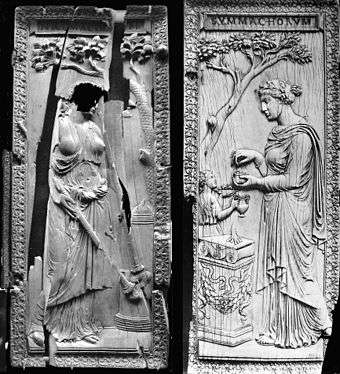Quintus Fabius Memmius Symmachus

Quintus Fabius Memmius Symmachus (383/384 - after 402) was a politician of the Roman empire, member of the influential family of the Symmachi.
Biography
He was son of the orator and politician Quintus Aurelius Symmachus and of Rusticiana; he was born in 383/384. Memmius had an elder sister, Galla, who married Nicomachus Flavianus, son of Virius Nicomachus Flavianus.
At the age of ten, he became quaestor, celebrating the public games connected with his office in December 393. Memmius was well educated, and studied Greek language; his father approved his style in writing letters and, in 401, he studied with a Gallic rhethor as his tutor. The year 401 marked several important events in Memmius' life: he married the granddaughter of Virius Nicomachus Flavianus;[1][2] he also celebrated the games connected with the second step in his cursus honorum, the office of praetor (these games were postponed from 400 in order to let Aurelius Symmachus to be present and cost 2000 pounds of gold).
It was probably Memmius who, belonging to a pagan family, built a temple devoted to Flora in Rome; he is also the author of a dedicatory inscription in honour of his father-in-law Flavianus (CIL, VI, 1782). After Aurelius Symmachus' death, Memmius edited his correspondence.
Notes
- ↑ Alan Cameron, "The Antiquity of the Symmachi", Historia: Zeitschrift für Alte Geschichte, 48 (1999), p. 503
- ↑ It was probably in this occasion that the bond between the two aristocratic, pagan families was celebrated with the issue of a diptych, whose valves are entitled one Nicomachorum and the other Symmachorum (Serena Ensoli, Eugenio La Rocca, Aurea Roma. Dalla città pagana alla città cristiana, L'ERMA di BRETSCHNEIDER, 2000, ISBN 88-8265-126-6, p. 467).
Bibliography
- Arnold Hugh Martin Jones, John Robert Martindale, John Morris, "Q. Fabius Memmius Symmachus 10", The Prosopography of the Later Roman Empire, Cambridge University Press, 1971, ISBN 0-521-20159-4, pp. 1046–1047.